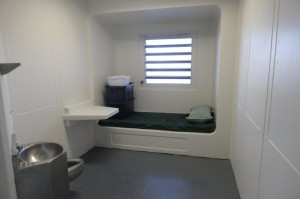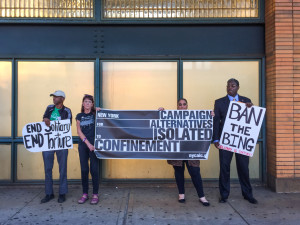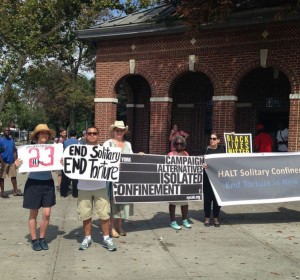By Julia Hettiger. Reprinted from Solitary Watch.
One year after the high-profile escape of two men from Clinton Correctional Facility, the Correctional Association of New York, the state’s oldest prison reform organization, has released a scathing new report on the brutality that followed the escape. Voices from Clinton documents cruelty often rising to the level of torture, and its subsequent cover up, in one of New York’s largest maximum security prisons.
In June 2015, two men serving murder sentences, Richard W. Matt and David Sweat, escaped from Clinton, in Dannemora, New York, after six months of planning. Matt was eventually killed, and Sweat was shot and captured and soon placed in long-term solitary confinement. According to a report made by the Department of Corrections Inspector General, the escape was possible because of security lapses by staff (and in one case, direct assistance). Some measures have been put into place to correct and enforce these procedures.
However, Inspector General’s the official report did little to document the abuse that has been visited upon those imprisoned at Clinton at the hands of the corrections officers, according to the Correctional Association. Voices from Clinton depicts firsthand accounts from the victims.
According to the report, conditions at the already notorious prison got significantly worse after the escape, which embarrassed Clinton staff and the entire prison system. Corrections officers have abused their power by abusing the men in their charge, issuing false disciplinary tickets, and sending men into solitary confinement for minor offenses. Solitary confinement has frequently been used as a coercive tool by these officers to instill fear and wrongly punish people.
One incarcerated man reported being beaten after being mistakenly identified as someone who aided Matt and Sweat in their escape. This included corrections officers slamming him into walls, placing him in handcuffs and shackles that were too tight and repeatedly punching and kicking him. The corrections officers behind the abuse never officially issued the incarcerated man a ticket until after he filed a grievance.
“I was in a lot of pain, couldn’t sleep, and ended up urinating blood. They finally took me to see a nurse, who did some documentation of my injuries. However, I never was able to see a doctor and they did not provide me with any treatment,” the man said. He still suffers from back and wrist issues to this day.
Although several incarcerated individuals have attempted to report the abuse, many of their claims go unheard or are ignored. Reports are falsified and injuries are downplayed in order to steer away any blame or punishment against the corrections officers. Some men have been beaten to the point of severe injury, and many endure verbal and emotional abuse as well. Rehabilitation programs at Clinton have been cut from the regimen, and many of the incarcerated people at the facility are being deprived of their basic human rights.
Multiple men shared their stories about the abuse they’ve received since the escape, with many of them reporting on their experiences while in solitary confinement. The report found that over half of the people in the Special Housing Unit (SHU) are there for falsely being accused of assaulting staff members, when many of them had been on the receiving end of assaults instead. In reality, 87 percent of the assaults at Clinton involved injuries to incarcerated people, with 28 percent resulting in injuries to staff members.
“And the staff brutality is rampant. If they don’t like what you say, they just jump on you,” an incarcerated man said about the abuse he has witnessed while at Clinton, including corrections officers placing plastic bags over people’s heads and choking others with scarves. “You could die in here. And everything will just go under the rug,” he said.
Issues at Clinton likely stem in part from racial differences between prisoners and corrections officers. During the CA’s visit to Clinton, they learned that there was not one Black corrections officer working at the facility and only .05 percent of the officers were Latino. This was a shocking divide, given that 22 percent of the incarcerated people at Clinton are Latino and 53 percent are Black. According to the report, present racism fuels issues at Clinton, landing many Black and Latino men in the SHU or “keeplock”–a punishment that confines them to their cells for 23 hours a day.
An incarcerated Latino man said in the Correctional Association’s report that he faces problems with corrections officers because of a language barrier. He cannot participate in the majority of the programs available at Clinton as well, and has received abuse and punishment because of the lack of translation services.
“There are a lot of times when I do not understand what a staff member is saying to me or what they are telling me to do, and they don’t let other Spanish speaking incarcerated people help. I can’t even submit a grievance because you are not allowed to write it in Spanish,” the man said.
The report also documents problems arising for incarcerated individuals who have special needs. A few reported witnessing officers punish them with extra severity, while one man with special needs spoke about the negative effects of solitary confinement on his well-being, such as high levels of stress and depression.
According to testimony included in the report, the majority of the people who are victims of assaults by staff are issued a ticket sentencing them to solitary confinement. While in the SHU, many of have endured inhumane conditions. “COs not only mess with our food trays in the SHU, but they also deny us showers and don’t take us to recreation,” one man said. Others have also reported the unsanitary conditions of their cells, including not being given mop privileges and having bug infestations due to the lack of screens on their windows.
“Since the escape, things have long gotten worse at Clinton,” an incarcerated man is quoted in the report. Before Matt and Sweat’s escape, Clinton was already a notoriously violent facility, but the brutality has since intensified. Many men who wish to file reports or contact the media about the conditions at Clinton are immediately sentenced to long-term solitary confinement. “The brutality and the use of endless solitary are perpetually punishing people under the guise of security,” the same incarcerated man said.
A spokesperson for the New York State Department of Corrections and Community Supervision (DOCCS) said in a statement released to the Albany Times-Union and other media that the Correctional Association has “no hands-on experience working in or managing a correctional facility.” (The group has had full access to visit and inspect New York’s prisons for more than 170 years.) “While the department will review the report, this is not the first time that this association has leveled accusations against the agency to serve its agenda,” the statement from DOCCS continued.
The union representing corrections officers, NYSCOBA, called the accusations “baseless” and the report biased because it was based on interviews with “75 inmates who couldn’t live within the rules of society.”
In its final words, the Voices from Clinton calls for reform. The incarcerated people at Clinton have undergone serious punishment since the escape. Many are left bloodied, defeated and without the will to carry on. “Overall, New York must reverse the downward spiral toward persistent punishment and warehousing at Clinton and across DOCCS, and envision a system where the state puts people before prisons,” the report said.



Follow the #HALTsolitary Campaign